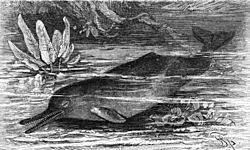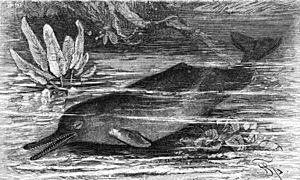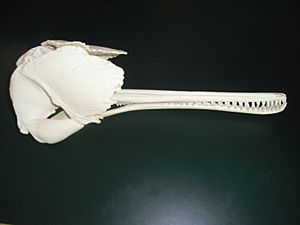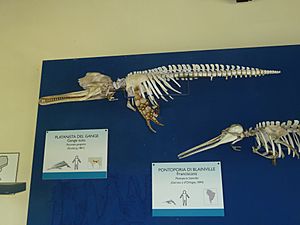Ganges river dolphin facts for kids
Quick facts for kids Ganges river dolphin |
|
|---|---|
 |
|
| Ganges River Dolphin Photographer:Brian D. Smith |
|
 |
|
| Size comparison against an average human | |
| Conservation status | |
| Scientific classification | |
| Kingdom: | |
| Class: | |
| Order: | |
| Suborder: | |
| Superfamily: | |
| Family: |
Platanistidae
|
| Genus: |
Platanista
|
| Subspecies: |
Platanista gangetica gangetica
|
 |
|
| Ranges of the Indus River Dolphin and the Ganges River Dolphin | |
The Ganges river dolphin (Platanista gangetica gangetica) is a special type of river dolphin. You can find it in the Ganges and Brahmaputra Rivers. These rivers flow through India, Nepal, and Bangladesh.
Ganges river dolphins are different from Indus river dolphins. Indus dolphins live only in Pakistan. People often call the Ganges river dolphin "Ganga Susu" or "Shushuk". It is even the National Aquatic Animal of India. This dolphin is special because it can only live in clean, fresh water.
Contents
What the Ganges River Dolphin Looks Like
The Ganges river dolphin has a long, pointy nose. This is a common feature for all river dolphins. You can see its teeth even when its mouth is closed. Young dolphins have thin, curved teeth. As they get older, their teeth change. They become flat, square, and bony disks. The dolphin's snout gets thicker at the end.
These dolphins are effectively blind. They do not have a special part in their eyes called a crystalline eye lens. This means they cannot see clear images. However, they can still tell how bright the light is and where it comes from. They use echolocation to find their way around and hunt. Echolocation is like using sound waves to "see" things.
Ganges river dolphins are unique among whales and dolphins. They often swim on their sides. Their bodies are brownish and a bit thick in the middle. Instead of a tall dorsal fin, they have a small, triangular bump. Their flippers and tail are thin but large compared to their body. Males are usually about 2 to 2.2 meters long. Females are larger, reaching about 2.4 to 2.6 meters. The oldest known dolphin lived to be 28 years old.
Where Ganges River Dolphins Live
South Asian river dolphins live in freshwater rivers. These rivers are found in Nepal, India, Bangladesh, and Pakistan. They prefer areas where there is a lot of food and the water flow is not too fast.
The Ganges subspecies (P. g. gangetica) lives in the Ganges-Brahmaputra-Meghna and Karnaphuli-Sangu river systems. These are mainly in Bangladesh and India. In the past, they also lived in Nepal. You can still find a small group in the Ghaghara River. They might also be in the Sapta Kosi River.
The Indus subspecies (P. g. minor) mostly lives in Pakistan. They are found between the Sukkur and Guddu barrages in the Sindh Province. Smaller groups are also in the Punjab and Khyber Pakhtunkhwa Provinces.
It's a bit of a mystery how these two groups of dolphins ended up in different rivers. The river systems are not connected by sea. It's too far for the dolphins to swim between them. One idea is that some rivers in northern India changed their paths long ago. This might have carried the dolphins to their current homes.
Life Cycle and Habits
Ganges river dolphins can give birth all year round. However, most births happen between December and January, and from March to May. A mother dolphin carries her baby for about 9 to 10 months. Young dolphins drink their mother's milk for about one year. They become adults and can have their own babies when they are about 10 years old.
During the monsoon season, these dolphins often move into smaller rivers. These smaller rivers are called tributaries. Sometimes, you might see them swimming with their noses sticking out of the water. They can also "breach," which means jumping partly or fully out of the water. They usually land on their sides.
Ganges river dolphins eat many different kinds of food. They enjoy various shrimp and fish. This includes fish like carp and catfish. These dolphins are usually found alone. Sometimes, they are in loose groups. They do not form large, close-knit social groups.
Images for kids
-
In Sundarbans, Bangladesh
See also
 In Spanish: Delfín del Ganges para niños
In Spanish: Delfín del Ganges para niños







